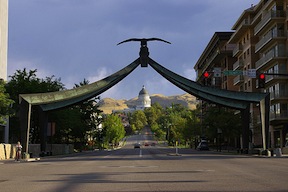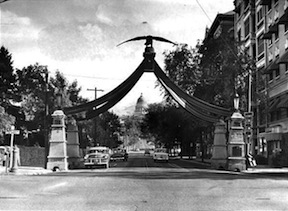Eagle Gate Monument
The Eagle Gate Monument is a historical monument with significance to members of The Church of Jesus Christ of Latter-day Saints. It arches over five lanes of State Street traffic at the southeast corner of Temple Square in Salt Lake City, Utah.
When the arch was built in 1859, it signified the entrance to the property of Brigham Young, who owned fifty acres of farmland upon which his homes the Lion House and the Beehive House were located. The Church Tithing Office was positioned nearest to the gate. Originally the arch spanned twenty-two feet and became a gate through its attachment to nine-foot-high cobblestone pillars on either side of the opening. The public could access the city water and timberland available in City Creek Canyon through the gate.
The original gate was designed by Truman O. Angell and Hiram B. Clawson. Ralph Ramsay and William Spring carved the original eagle that sat atop the peak of the arch. The eagle was formed (based on an actual eagle that had been found in City Creek) from five different blocks of wood: one for the body, another for the neck and head, one for each wing, and one for a beehive and star mount upon which the eagle rested. The pieces were held together with iron and spanned sixteen feet.
The monument has been altered four times to accommodate the widening of State Street for streetcars and then traffic flow. In 1891, the gates were removed, the street was widened to two lanes, and the monument was refurbished with a design by Don Carlos Young, one of Brigham Young’s sons. The eagle was repaired and electroplated in copper, the arches, originally of wood, were reinforced with iron pipe and lengthened, and new, carved sandstone pillars replaced the old ones.
At one point, city officials considered removing the monument altogether, but were persuaded to keep it through the efforts of concerned citizens such as Alice Merrill Horne. At the gate’s dedication in 1963, then Church president David O. McKay noted: “Over the years many attempts have been made to remove the old eagle and its perch in the interest of progress, better traffic control and for esthetic reasons, but they came to naught and the gate has remained as a famous landmark.’[1]
In 1947, Eagle Gate was refurbished again for Utah’s Centennial Celebration. When a flatbed truck carrying a tractor hit one of the pillars in 1960, the monument was knocked off its foundation and the gate was taken down again. This time, architect George Cannon Young, a grandson of Brigham Young, designed a new frame to support the monument and artists Grant R. Fairbanks, David Fairbanks, and Justin Fairbanks created a replica of the original bird, formed with a twenty-foot wingspan, ten-foot long body, and comprised of 4,000 pounds of bronze. A time capsule dating to 1891 was found in one of the bases of the old support columns and for more than three years, there was no Eagle Gate at State Street and South Temple. The stone fence was moved twenty feet closer to the Lion House to allow for five lanes of traffic—a span of seventy-four feet.
State highway funds financed the project, but the Church of Jesus Christ granted the state millions of dollars in rights of way for the project. A large bronze plaque at the northeast corner of Main and South Temple says Eagle Gate has come to represent both Brigham Young and the pioneer spirit.
A replica of the monument was created in 2001 and welcomes visitors to This Is the Place Heritage Park. The original eagle sculpture is now housed at the Daughters of Utah Pioneers Museum near the State Capital building in Salt Lake City.


